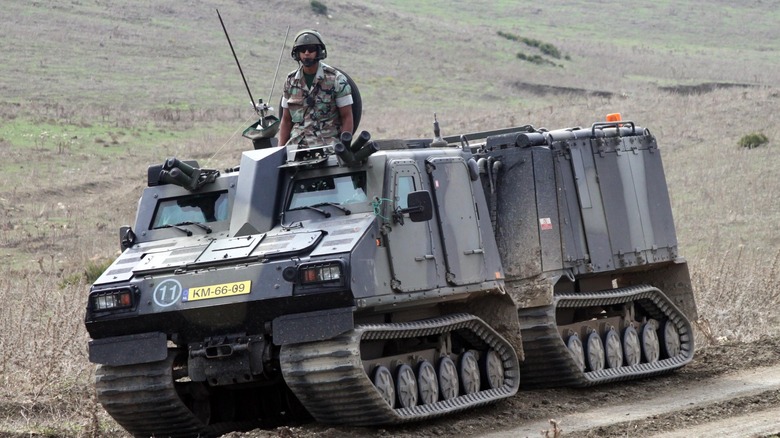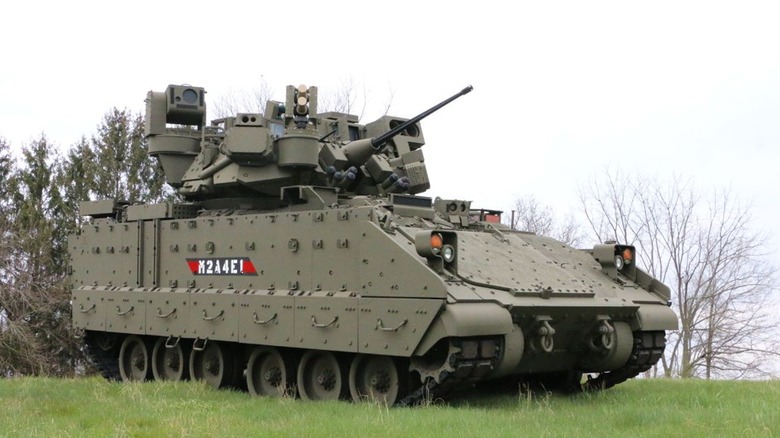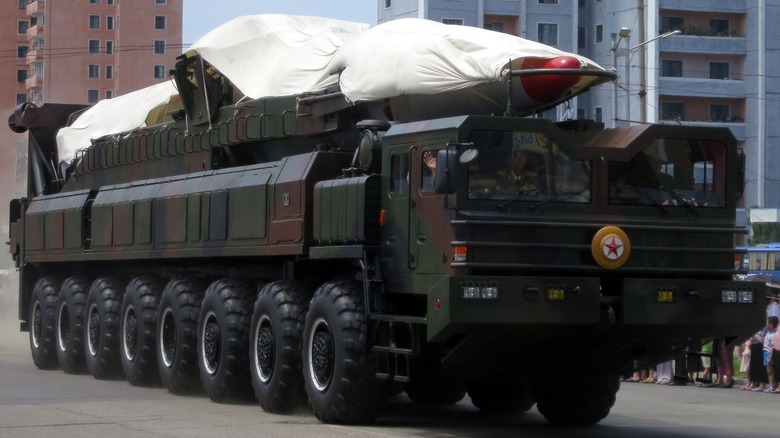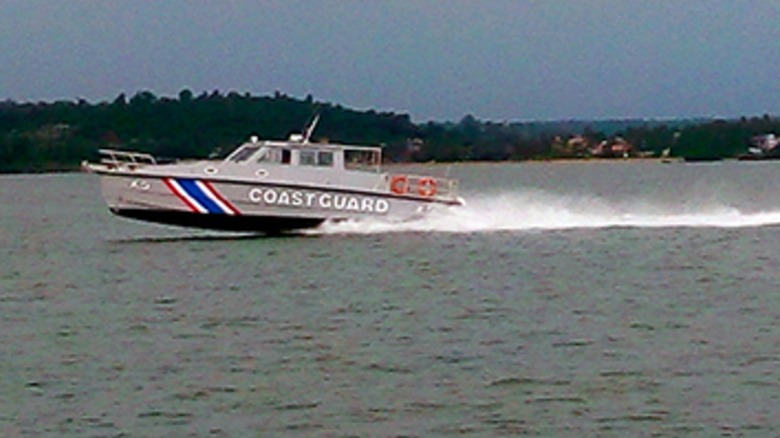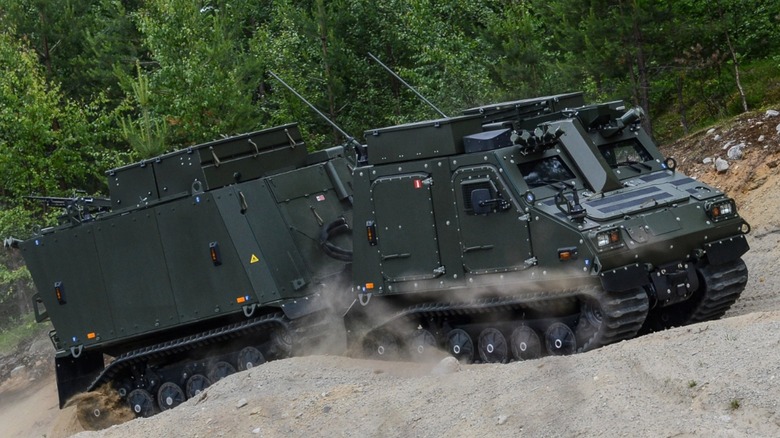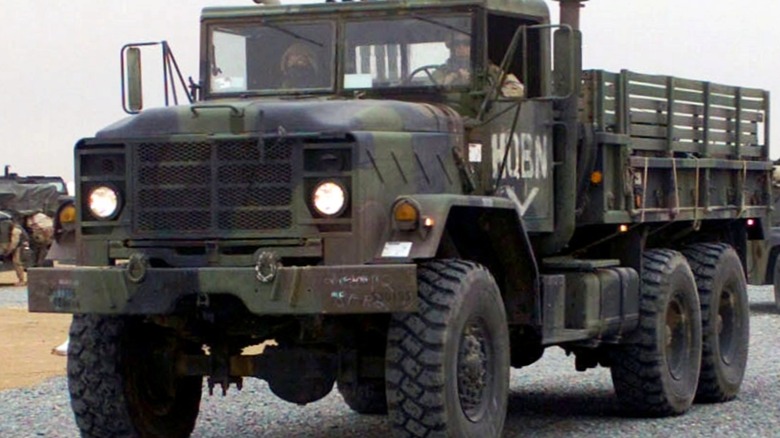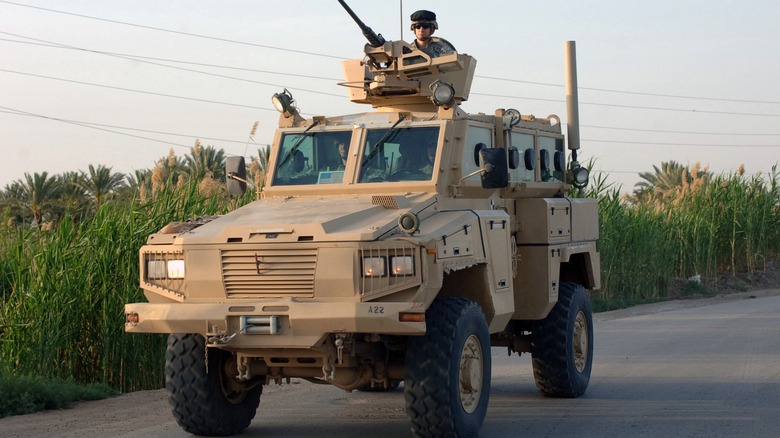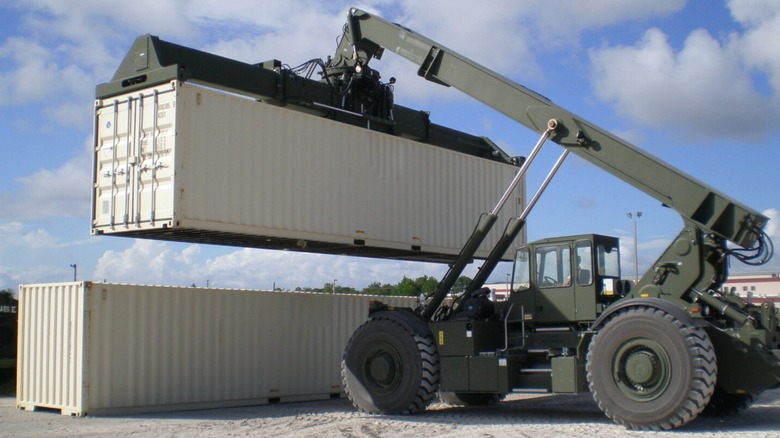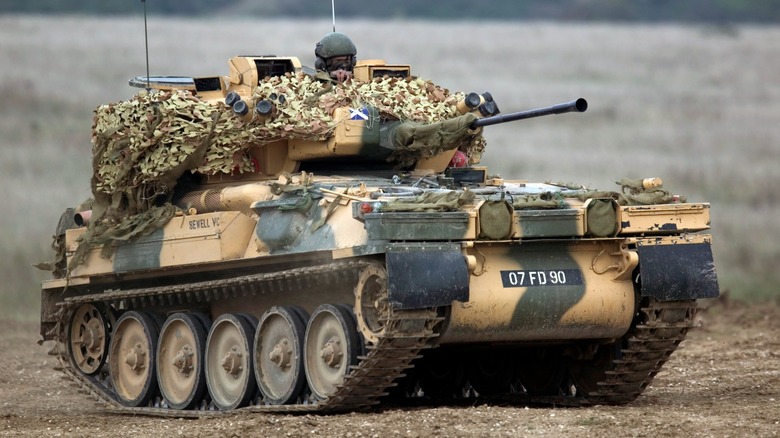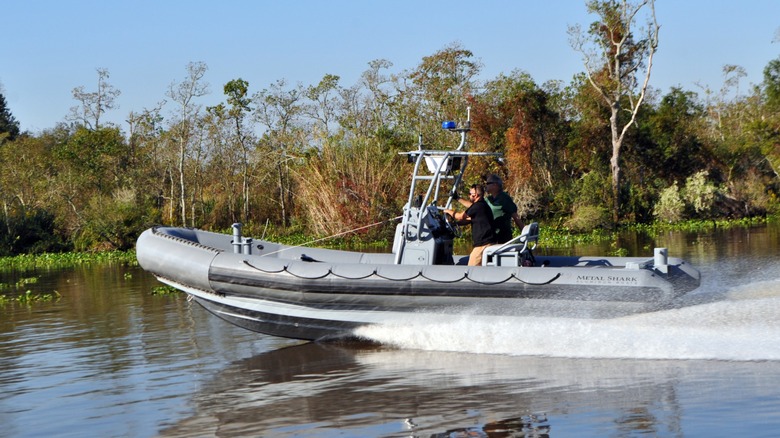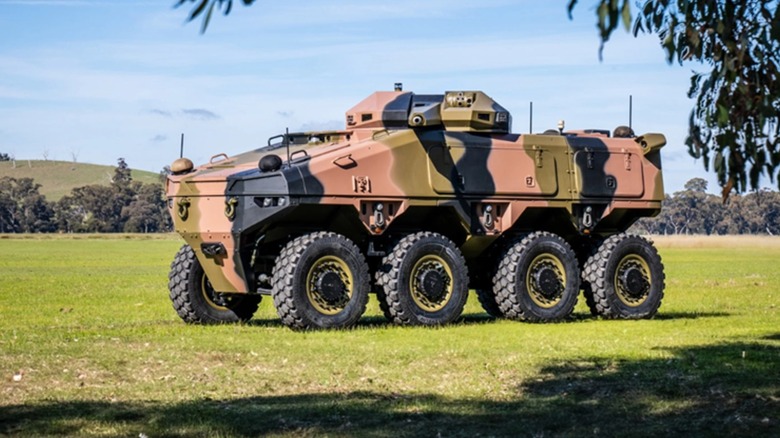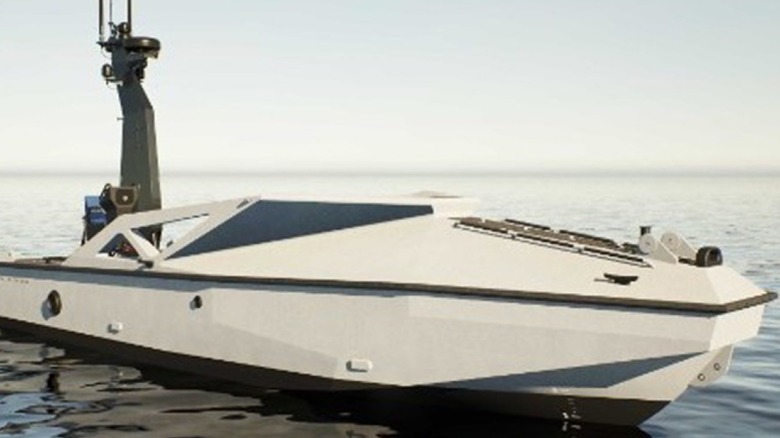10 Military Vehicles That Use A Cummins Engine (And Two That Will)
Every modern vehicle needs a motor of some kind, usually an internal combustion engine. Given the prevalence of cars, lots of people take the time to learn the ins and outs of the best and worst engines used by major automakers, but it's easy to overlook what goes into military vehicles because, well, they're military vehicles. Shouldn't the inner workings of these tanks, planes, and trucks be a closely guarded secret? Surprisingly, no.
Many companies actually collaborate with military engineers to design the countless components that go into military vehicles. One such manufacturer is Cummins. This company designs and builds parts integral to modern vehicles, including brakes, suspension systems, and for the purposes of this article, engines. You can find Cummins diesel engines in everything from commercial pickup trucks to government boats, and yes, some Cummins serve as the beating heart of military vehicles such as heavy-duty trucks, all-terrain vehicles (ATVs), and even tanks and tank-adjacent machines. Cummins has built a name for itself providing powerful and reliable engines, so much so that the company has even landed contracts to provide the engines for future war machines — or at least the prototypes for these mobile weapons.
Here are 10 modern military vehicles (and two upcoming ones) brought to life through the power of Cummins engineering.
Bradley Fighting Vehicle
Military vehicles can have some confusing classifications. For instance, did you know there are around seven types of battle tank (eight if you count the archaic and outdated super-heavy tanks)? And while armored cars can transport personnel, they are distinct from armored personnel carriers (APCs). And then there's the Bradley Fighting Vehicle.
The Bradley Fighting Vehicle (BFV) is a line of tracked armored vehicles that superficially resembles tanks but are classified as infantry fighting vehicles — the difference being that infantry fighting vehicles are designed to carry infantry while also providing fire support. The U.S. Army has been using BFVs since the 1980s, and BAE Systems manufactures these vehicles. Lockheed Martin also borrowed the BFV chassis to create its M270 Multiple Launch Rocket System.
Since the Army has fielded BFVs for several decades, the armored (and armed) personnel carrier has gone through a few generations of Cummins engines. Currently, these vehicles are powered by the latest V903 engine, which can provide up to 760 hp and around 1570 lb-ft (2,129 Newton-meters) of torque. The previous engine under the BFV's hood was another Cummins VTA-903 engine that could deliver 600 hp. And of course, since the M270 shares a chassis with the BFV, it uses the same Cummins engine.
WS51200
While militaries around the globe field tons of vehicle types — tanks, submarines, helicopters, jets, and more — at the end of the day, there are really only two kinds: Those designed for military purposes, and those modified to serve military purposes. And we're not just talking about civilian car models used by military personnel.
The WS51200 is a Chinese heavy goods transport vehicle similar to the Russian MZKT-79221, the 16-wheeler "transporter erector launcher" used to fire the Topol M intercontinental ballistic missile (ICBM). While China retired the WS51200, the vehicle has been spotted in North Korea serving the same purpose: carrying ICBMs. And like many "military" vehicles in North Korea, the country's army obtained the WS51200 illegally.
Regardless of any modifications the North Korean military gave the WS51200, it is believed that the ICBM transports kept their original engines, which is a Cummins KTAA19 C700. This diesel engine is rated at 700 hp and can provide up to around 2,020 lb-ft (2,739 Newton-meters) of torque. While North Korea can manufacture cars, its production capabilities are limited, so it's unlikely the country canl keep its small fleet of WS51200s running reliably, especially if anything happens to their engines.
Mauritius Fast Interceptor Boats
While some countries have money to burn on military spending, some don't even have militaries and rely on others to guard their borders. But what about the nations that fall in the middle and have to scrimp and save to pay for their defense? Sometimes an army has to take what it can get, but that's not an issue when they can get some rather powerful engines.
The Republic of Mauritius is an island nation in the Indian Ocean, a few thousand miles off the coast of East Africa. While the country stretches across less than 800 square miles of land, Mauritius owns the surrounding 800,000 square miles of ocean. So in 2016, the country's Coast Guard commissioned the Indian company Goa Shipyards Limited to build 10 fast interceptor boats (FIBs) to help patrol these waters, Each boat is 14.3-14.5 meters long with a depth of less than one meter.
While India built the actual boats, Cummins supplied the engines, specifically QSC 8.3-liter engines. Each engine can churn out up to 600 hp and 1,327 lb-ft (1,799 Newton-meters) of torque. Since the FIBs skim over the water, they also need motors, so Cummins and Goa Shipyards Limited went with a Rolls Royce water jet with ZF 286 gears. Between this motor and the Cummins QSC 8.3-liter engine, Mauritius FIBs can travel up to 35 knots and carry up to 14 tons of cargo. To say the Mauritius government was impressed would be an understatement.
BvS 10 Viking
Just because two military vehicles share the same classification, doesn't mean they look similar. In fact, some can look rather weird; just consider some of the strangest M4 Sherman tanks to hit World War II battlefields. But regardless of how military vehicle's appearance, what truly matters is what's under the hood.
You've probably never seen a vehicle quite like the Bandvagn Skyddad 10, aka The BvS 10 Viking. This squat amphibious armored all-terrain vehicle was developed for the British Royal Marines and consists of a tracked driving unit pulling another tracked unit. They look like someone took an ATV, attached tank treads to the bottom, and squished them down. But despite this odd appearance, the British Marines have been using the Vikings since 2006.
In order to ferry soldiers across battlefields, the BvS 10 Viking utilizes a Cummins ISB engine, which provides 250 hp and 619 lb-ft (840 Newton-meters) of torque. On a not-so side note, the BvS 10 Viking was designed as the successor of the Bv206, a Swedish armored troop carrier that used tracks and consisted of two separate units. Yet despite weighing more than the Bv206, the BvS 10 Viking is twice as powerful thanks to its Cummins engine. With that sort of performance, it's no wonder you can find over 11,000 BvS 10s across the globe.
M939 Series 5-ton 6x6 truck
Military combat isn't just about fighting enemies and winning battles; preparation plays a key factor. You need to get your soldiers into position and transport all the necessary equipment. Tanks might be powerful, but they aren't exactly known for hauling cargo. For that, you need a bona fide truck with an equally bona fide engine.
AM General's M939 5-ton 6x6 truck is exactly what it sounds like: a heavy-duty truck. If you ever saw a movie or show that features contemporary soldiers driving around in military transport trucks, possibly with a tarp over the back, that either was or closely resembled an M939. While the U.S. Army still uses these vehicles, the Marine Corps is replacing its line of M939s (and M809 trucks) with the MTVR — literally "Medium Tactical Vehicle Replacement."
As the M939 5-ton 6x6 truck is...well, a truck designed to haul military equipment, it uses components more commonly seen in commercial vehicles. The more recent models (M939A2) rely on the turbocharged Cummins 6CTA8.3, whereas the first two models (M939 and M939A1) run on an NHC 250 engine. While the 6CTA8.3 churns out less horsepower than the NHC 250 (240 vs 250), the 6CTA8.3 is far more efficient (6 mpg versus 4 mpg). Since the M939 is supposed to haul heavy equipment over long distances, it's understandable the U.S. military wanted later models to get more miles to the gallon.
RG-31 Nyala
Every weapon and tool on the battlefield is designed to counter another weapon or tool. Facing infantry? Drive an armored vehicle. Fighting an armored vehicle? Use explosives such as mines. Afraid of mines? Roll out an armored vehicle. Wait a minute...
The RG-31 Nyala is an armored car manufactured by Land Systems OMC in South Africa. The vehicle is classified as an MRAP, which stands for "Mine-Resistant, Ambush-Protected." As you can probably guess, the vehicle is built to withstand mines and small arms fire. The former feature is the product of the RG-31 Nyala's V-shaped hull and high ground clearance – which also lets it drive over all sorts of terrain. Meanwhile, the Nyala is "ambush-protected" thanks to good old-fashioned armor and bulletproof glass.
Unlike other vehicles mentioned in this article, the RG-31 Nyala wasn't built around a Cummins engine. Instead, it is one of several options available to the vehicle. Depending on the customer, a Nyala can include a Daimler-Benz, Iveco, Detroit Diesel, or Cummins engine, specifically a QSB6.7 that can churn out 275 hp. Given this variety of options and the vehicle's performance, it's no wonder countless countries rely on the RG-31 Nyala. The Nyala is even the United Nations' peacekeeping operations armored car of choice.
RTCH/RT240
We've gone over vehicles built specifically for military use and ones that were modified for armies. But some companies also manufacture special models of commercial vehicles specifically for military use. What's the difference between these versions? The answer isn't the engine.
While some companies provide a variety of products, Independent Rough Terrain Center (previously Kalmar Rough Terrain Center) is known for one product: the Rough Terrain Container Handler (RTCH). This vehicle is a robust container lifter that can carry up to 56,000 pounds worth of goods in ISO containers – the same receptacles that you see stacked on cargo ships. Technically speaking, the RTCH is divided into two models: the commercial-oriented RT250 and the defense-centered RT240. However, good luck telling the two apart.
Looking at the components and specs, the RT250 and RT240 are almost identical. For instance, both RTCH models pack a Cummins QSM11 engine that can churn out 375 hp and travel anywhere between 15 and 23 mph depending on the load. While the RTCH is worthless in actual combat, regardless of model, this loading vehicle is touted as an indispensable element of material logistics, thanks in no small part to its Cummins engine. Plus, users can kit out the vehicle with any number of proprietary attachments so it can carry more than just ISO containers. So long as they weigh less than 56,000 pounds, that is.
FV107 Scimitar
Standardized parts are the backbone of the automobile industry. This design philosophy lets car modders upgrade their own engine parts for more horsepower. The same is true for military vehicles, and engineers can swap out parts such as engines to make even tanks roll across the battlefield faster.
The FV107 Scimitar is classified as an "armoured reconnaissance vehicle," aka a light tank. Despite being designed to spy on enemy positions, the vehicle is no slouch in a fight. With a 30mm L21 RARDEN cannon, the vehicle can punch through many defenses. Plus, the Scimitar has undergone somewhat recent enhancements to improve defense against mines and ballistic weaponry while also increasing the amount of room inside the tank's interior.
Initially, manufacturers equipped FV107 Scimitars with Jaguar J60 4.2-liter engines, the same engine that powered quite a few Jaguar cars. However, that changed when the British military decided to extend the Scimitar's tour of duty. As a result of this "Life Extension Programme," modern FV107 Scimitars now run on a Cummins BTA 5.9 engine, which extends the vehicle's operation range and even helps power an air conditioning system — under all that armor, sweating crewmates turn the insides of the tanks into veritable ovens. If the British military orders a "Scimitar Mk. III," Cummins might provide even more engines.
7M RIBS
Many people incorrectly associate military vehicles with armor. Yes, plenty of Army tanks, trucks, and cars are bulletproof, and research into composite materials will influence future tank armors, but depending on the situation, storage and rapid deployment can be more important factors.
Unfortunately, "7M RIBS" isn't a food – you'd need to cook a whale and use an ungodly amount of BBQ sauce. It's actually an acronym for "seven-meter Rigid-hull Inflatable Boat"; while some sources spell the acronym "RHIB," they're the same vehicle. As the full name suggests, these are inflatable vessels with fiberglass hulls designed to be quickly deployed. If the U.S. Navy needs to send a boarding party to search and potentially seize a suspicious boat, they use a 7M RIB. And when soldiers are done, these boats deflate to fit rigid stowage restrictions.
While companies such as Metal Shark provide 7M RIB bodies, Cummins has been supplying the engines since 2005. Specifically, these hard-bodied dinghies use QSB5.9 230 engines with sterndrive, which can deliver up to 472 horsepower. While 7M RIBS can also use twin gas outboard and single diesel water jet engines, the U.S. Navy seems to prefer combining Metal Shark boats with Cummins engines, as evidenced by an upcoming project that combines their expertise (more on that later).
M109 Paladin
When most people think of a howitzer, they picture an entrenched cannon pelting enemies from miles away with a deadly rain of artillery. However, that's only one form of howitzer. Some can be driven or hauled to reposition much more easily. These weapons are classified as self-propelled artillery, and while some resemble tanks, they are two distinct weapons. They both need engines, though.
At first glance, the M109 Paladin might look like a tank, but this self-propelled howitzer's 155mm turret is far too long for a standard tank and set way back in the rear of the main chassis. Plus, the barrel of the turret is secured via a locking mechanism until the crew needs it. You might easily confuse a Paladin for a tank from the front, but once you get it in profile, the differences become clear.
The United States has been using the M109 Paladin since the early 1960s. As such, the vehicle has undergone several reworks, mostly concerning the turret. Early models wielded 23-caliber barrels, but they later upgraded to the much more devastating 39-caliber. However, we're here to talk about engines, not armaments. For most of its life, the. M109 was powered by Detroit Diesel 8V71T engines, but the latest generation, the M109A7 Paladin, harnesses the power of the 675 hp Cummins V903 engine. This engine was intentionally chosen to provide some "commonality" between the Paladin and the Bradley Fighting Vehicle. These vehicles also now share the same transmission, road wheels, torsion bars, and final drives.
ATLAS CCV
Military attack drones have come a long way, and while many people associate the term with airborne devices, there are unmanned ground vehicles, too. Some companies believe that unmanned ground vehicles are the future of warfare, and Cummins is along for the ride.
In 2024, BAE Systems announced the Autonomous Tactical Light Armour System Collaborative Combat Variant, aka the ATLAS CCV. This vehicle is touted as an "uncrewed ground vehicle" that can complement crewed vehicles such as Infantry Fighting Vehicles and tanks. The ATLAS CCV will support a variety of control modes, such as remote piloting and following premade waypoints while weaving in real-time obstacle avoidance. "Versatility" is the driving design factor behind the ATLAS, so it will be able to undertake combat roles ranging from reconnaissance to fire support.
Technically, the ATLAS CCV isn't an exclusive BAE Systems project but a collaboration between that company and Cummins. While BAE is in charge of the vehicle's frame and systems, Cummins will supply the engine. Currently, Cummins and Bae plan to place a Cummins ISB 6.7-liter engine under the ATLAS CCV's hood, which will provide 185 hp. Since the ATLAS CCV is under development, only time will tell if this engine is enough for the final product...or if Cummins will contribute any other components to the vehicle.
LRUSV
As we previously went over, Metal Shark is one of the main providers of 7M RIB vessels, but the company is no one-trick sea pony. The company also manufactures and sells catamarans, skiffs, yachts, and towboats, and it is hard at work on a prototype ship for the U.S. Marines. Although, can you call a ship a ship if nobody is aboard?
Metal Shark's latest project is the Long Range Unmanned Surface Vessel System, or LRUSV for short. Developed by Metal Shark's Sharktech Autonomous Vessels division, the prototype ship is intended to provide a turnkey solution for missions too dangerous or risky for a human crew – or when there isn't enough time to fully staff a boat. At the flip of a switch, users will be able to turn on autonomous or remote piloting, as well as automate systems and components such as sirens, safety lights, and even specialized devices like fire pumps and acoustic oceanography equipment.
Like the ATLAS CCV, the LRUSV isn't a one-company operation. According to the Cummins website, they are involved in some way with the project, as the webpage devoted to the company's marine government and defense solutions page cites the LRUSV as one of its engine applications. However, unlike the ATLAS CCV, Cummins hasn't revealed which marine motor Metal Shark is using for the project. Then again, Metal Shark hasn't provided any stats for the LRUSV, either, so we'll just have to wait and see.
